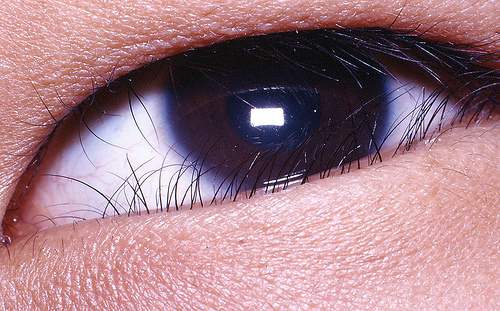Entropion
- Details
- Published: 27 February 2015
- Hits: 5043
An entropion is when one eyelid (usually the lower) folds inward. The lid then rubs against the eyeball. The eyelid may turn in only when the eye closes during sleep, blinks or it may happen all of the time. This usually happens in older people when the skin and muscle tone of the face becomes loose with age.

CAUSES
• Aging skin and muscle changes.
• Abnormal anatomy of the inside of the eyelid (tarsal plate).
• Scarring from burns, chemical burns, trauma, or past plastic or facial surgery.
• Certain skin diseases (e.g. ocular cicatricial pemphigoid).
SYMPTOMS
• Eye irritation.
• Feeling like something is in your eye.
• Pain or light sensitivity. This can happen if the lashes scratch the eye.
• Constant tearing.
DIAGNOSIS
An eye professional can tell you if you have an entropion during an eye exam.
LET YOUR CAREGIVER KNOW ABOUT:
• Allergies.
• Medications taken including herbs, eye drops, prescription medications, over-the-counter medications, and creams.
• Use of steroids, such as prednisone (by mouth or creams).
• Use of aspirin or blood-thinning medicines.
• History of bleeding or blood problems.
• Past problems with anesthetics or novocaine.
• Possibility of pregnancy, if this applies.
• History of blood clots (thrombophlebitis).
• Past surgery.
• Other health problems.
BEFORE THE PROCEDURE
An ophthalmologist may prescribe drops or ointments to relieve irritation and protect the eyeball until the entropian is repaired.
PROCEDURE
• If the lid turns in all of the time, surgery will be needed. In mild cases, relief may be possible by using a thin piece of tape to pull down on the skin below the eyelid to keep it from turning in.
• Surgery can be done on an outpatient basis.
• Surgery stops damage to the eyeball. It also helps stop vision loss that can happen as a result of cornea damage.
• A needle may be used to inject a drug (local anesthesia) in the eyelid to make the area loose feeling.
• There are many ways to repair entropions. All repairs tighten the skin and muscles of the lid to stop it from turning in.
AFTER THE PROCEDURE
Some stitches may need to be removed. They may be removed all at once or in steps between 5 and 10 days after surgery. Sometimes stitches that keep the eyelid edges lined up are left for a few days longer than the stitches in the skin of the eyelid.
HOME CARE INSTRUCTIONS
• Eye drops, ointments or pills by mouth may be prescribed. Use as directed.
• Let your caregiver know if your eye becomes more red and swollen with the use of medications. This could be an allergic reaction.
• Only take over-the-counter or prescription medicines for pain, discomfort or fever as directed by your caregiver.
• The material used to cover the wound (dressing) should be kept clean and dry until removed or changed. Do as directed by your caregiver.
• Avoid lifting and bending over until you are told otherwise.
• Recovery time is short. You may resume normal activities as directed or allowed.
SEEK MEDICAL CARE IF:
• You have redness, swelling, or increasing pain in the wound or around the eye or face.
• You notice pus coming from the wound.
• Your eye itself becomes red and inflamed.
• Your eye is sensitive to light.
• You have a breaking open of the wound edges after stitches (sutures) have been removed.
• You still feel like you have something in your eye after the surgery.
SEEK IMMEDIATE MEDICAL CARE IF:
• You have a fever.
• You have any change in vision.
• You develop a rash.
• You have a hard time breathing.
• You develop any reaction or side effects to medicines given.
